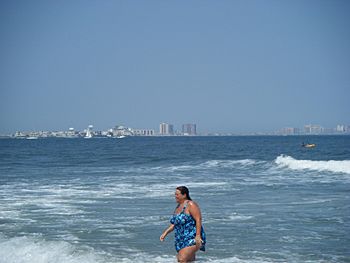Absecon Island facts for kids

Absecon Island viewed from Ocean City, New Jersey
|
|
| Etymology | Lenape Absegami ("little water") |
|---|---|
| Geography | |
| Location | Atlantic Ocean |
| Coordinates | 39°20′45″N 74°29′34″W / 39.345748°N 74.492712°W |
| Type | Barrier island |
| Adjacent bodies of water | Absecon Inlet |
| Administration | |
| State | New Jersey |
| County | Atlantic |
| Largest settlement | Atlantic City (pop. 39,558) |
| Demographics | |
| Population | 57,457 (2010) |
Absecon Island is a long, narrow island located on the Jersey Shore in New Jersey. It sits right on the Atlantic Ocean. This island is home to several well-known resort towns. From north to south, these include Atlantic City, Ventnor, Margate, and Longport. The island is bordered by Absecon Inlet to the north and Great Egg Harbor Inlet to the south.
Contents
Exploring Absecon Island's Shape
Absecon Island is a type of landform called a barrier island. Barrier islands are long, narrow islands that run parallel to the mainland coast. They act like a natural shield, protecting the mainland from strong ocean waves and storms. Absecon Island stretches between Absecon Inlet in the northeast and Great Egg Harbor Inlet in the southwest.
People have described Absecon Island for a long time. In 1834, it was called "Absecum Beach." It was noted to be about 9 miles long. It extended from Great Egg Harbour Inlet to Absecum Inlet. There was also a small, narrow inlet about halfway along its length.
In 1878, another description called it "Absecon Beach." It was said to be about ten miles long. The northeastern part of the island had some trees. This is where Atlantic City, also known as the "City by the Sea," was built after 1853. Before that, it was mostly wild land with only a few families living there. There were also large salt works near Absecon Inlet.
The History of Absecon Island
Early Settlers and the Island's Name
The first European settlers on Absecon Island were English. They made their living by collecting clams and oysters from the water. They bought land not for farming, but to control access to the waterways. The name "Absecon" comes from the Lenape word "Absegami." This word means "little water." It was given by the Native Americans who lived along Absecon Creek.
Land Purchases and Atlantic City's Beginnings
In 1695, a man named Thomas Budd bought a huge amount of land. He purchased 10,000 acres (about 40 square kilometers) in what later became Atlantic County. He paid only 4 cents per acre for the land where Atlantic City now stands. This area was first called Further Island. Later, it was known as Absecon Beach. Finally, it became Atlantic City.
The First Permanent Resident
Jeremiah Leeds was the first person to settle permanently on Absecon Island. He arrived in 1785 when the island was still a complete wilderness. He built a small cabin from cedar logs. He also cleared a field where the Atlantic City Expressway now ends in Atlantic City. The area known as Columbus Plaza was once part of the Leeds family farm. Most of the homes in Atlantic City built before 1854 were constructed by Jeremiah Leeds's family members. His son, Chalkey S. Leeds, became the first mayor of Atlantic City in 1854. His youngest son, Robert, became the first postmaster of Atlantic City.
Dr. Pitney and the Rise of a Resort
In 1819, Dr. Jonathan Pitney moved to Absecon to start his medical practice. During his visits to Absecon Island, he realized something important. He believed the island had the perfect climate for a health resort. He worked hard to convince local leaders that building a railroad to the beach would be very helpful. Because of his efforts, Dr. Pitney is often called the "Father of Atlantic City."
The Famous Boardwalk
The first beachwalk, or "boardwalk," in Atlantic City was finished in 1870. It was built by Simon Luchs Wescoat. The resort became very popular. Because of this success, a second railroad was built in 1877. Fifty-four miles of track were laid in a very short time, just 98 days!
Protecting Absecon Island's Beaches
As a barrier island, Absecon Island's beaches are always changing. They are constantly affected by coastal erosion. This is especially true during strong storms like nor'easters and hurricanes. To help protect the island, the United States Army Corps of Engineers is working on a big project. They are building a beach and dune system along the 8.1-mile oceanfront of Absecon Island. This project costs about $63 million.

